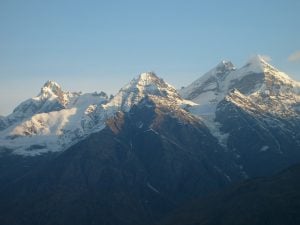Some talk of hoisting mirrors into space to reflect sunlight, while others want to cloud the high atmosphere with millions of tonnes of shiny sulphur dust. Now, scientists may have dreamed up the most ambitious geoengineering plan to deal with climate change yet: converting the parched Sahara desert to a lush forest. The scale of the ambition is matched only by the promised rewards – the scientists behind the plan say it could “end global warming”.
The scheme has been thought up by Leonard Ornstein, a cell biologist at the Mount Sinai School of Medicine in New York City, together with Igor Aleinov and David Rind, climate modellers at NASA. The trio have outlined their plan in a new paper published in the Journal of Climatic Change, and they modestly conclude it “probably provides the best, near-term route to complete control of greenhouse-gas-induced global warming”.
Under the scheme, planted fields of fast growing trees such as eucalyptus would cover the deserts of the Sahara and Australian outback, watered by seawater treated by a string of coastal desalination plants and channelled through a vast irrigation network. The new blanket of tree cover would bring its own weather system and rainfall, while soaking up carbon dioxide from the world’s atmosphere. The team’s calculations suggest the forested deserts could draw down around eight billion tonnes of carbon a year, about the same as emitted from fossil fuels and deforestation today. Sounds expensive? The researchers say it could be more economic than planned global investment in carbon capture and storage (CCS) technology.
“The costs are enormous but the scale of the problem is enormous,” says Ornstein, who is best known for pioneering a cell biology technique called polyacrylamide gel electrophoresis in the 1950s. “It’s a serious suggestion, in that I believe it is the most promising and practical option in terms of current technology to solve the biggest parts of the problem.”
The scheme could cost US$1.9 trillion a year, he says. “When that’s compared to figures like estimates of $800 billion per year for CCS, our plan looks like a loser. But CCS can address only about 20% of the problem at the $800 billion price. Mine addresses the whole thing. And CCS would involve a network of dangerous high-pressure pipelines coursing through the most developed neighbourhoods of our civilisations, compared to relatively benign water aqueducts in what are presently virtually uninhabited deserts.”
Planting trees to combat rising carbon-dioxide levels is controversial on a large scale, because most places where it has been suggested, such as Canada and Siberia, are in the northern hemisphere where the resulting change in surface colour, from predominantly light snow and rock to predominantly dark trees, could soak up more sunlight and cancel out the cooling benefit.
Ornstein says subtropical regions, such as the Sahara and the Australian outback, do not have this problem. The areas have only minimal “human occupation, agricultural food and fibre resources and competing natural biomes”, the team says. “We must bite the bullet; global warming will not go away by itself … solar, geothermal and wind power can make modest contributions. All of these are other parts of a fix. But the quicker a forest can be grown, the more time will be available to choose among and to implement such adjustments, and perhaps to develop more attractive substitutes.”
Ornstein says several desert-heavy countries are suitable, including large chunks of Saudi Arabia and a string of African nations west of Egypt. The scheme would provide jobs and investment, he says, as well as a long-term source of sustainable wood that could be used as a biofuel to replace fossil fuels. Other plans for the desert region, such as the installation of giant arrays of mirrors and solar panels to generate electricity would not be affected, he says. Tree-planters, and the resulting clouds, would stick to the flatter regions further south.
Since the paper was published recently, Ornstein has attempted to seed serious discussions on specialist websites, with little success. Critics have pointed out that the deserts are not total wildernesses, but rich and diverse ecosystems in their own right, which would be destroyed. Ornstein says: “If sacrifices are required to stem global warming, the almost non-existent ecosystems of the central Sahara and the outback seem like reasonable candidates compared to the alternatives.”
The scheme does have some support. “It is incredibly important and definitely worth taking seriously,” says Rick Anthes, president of the University Corporation for Atmospheric Research (UCAR) in Boulder, Colorado. “While there are many practical and political difficulties of afforestation of regions this large, the benefits could be enormous and go well beyond carbon sequestration.”
Copyright Guardian News and Media Limited 2009
Homepage image by alex lichtenberger




